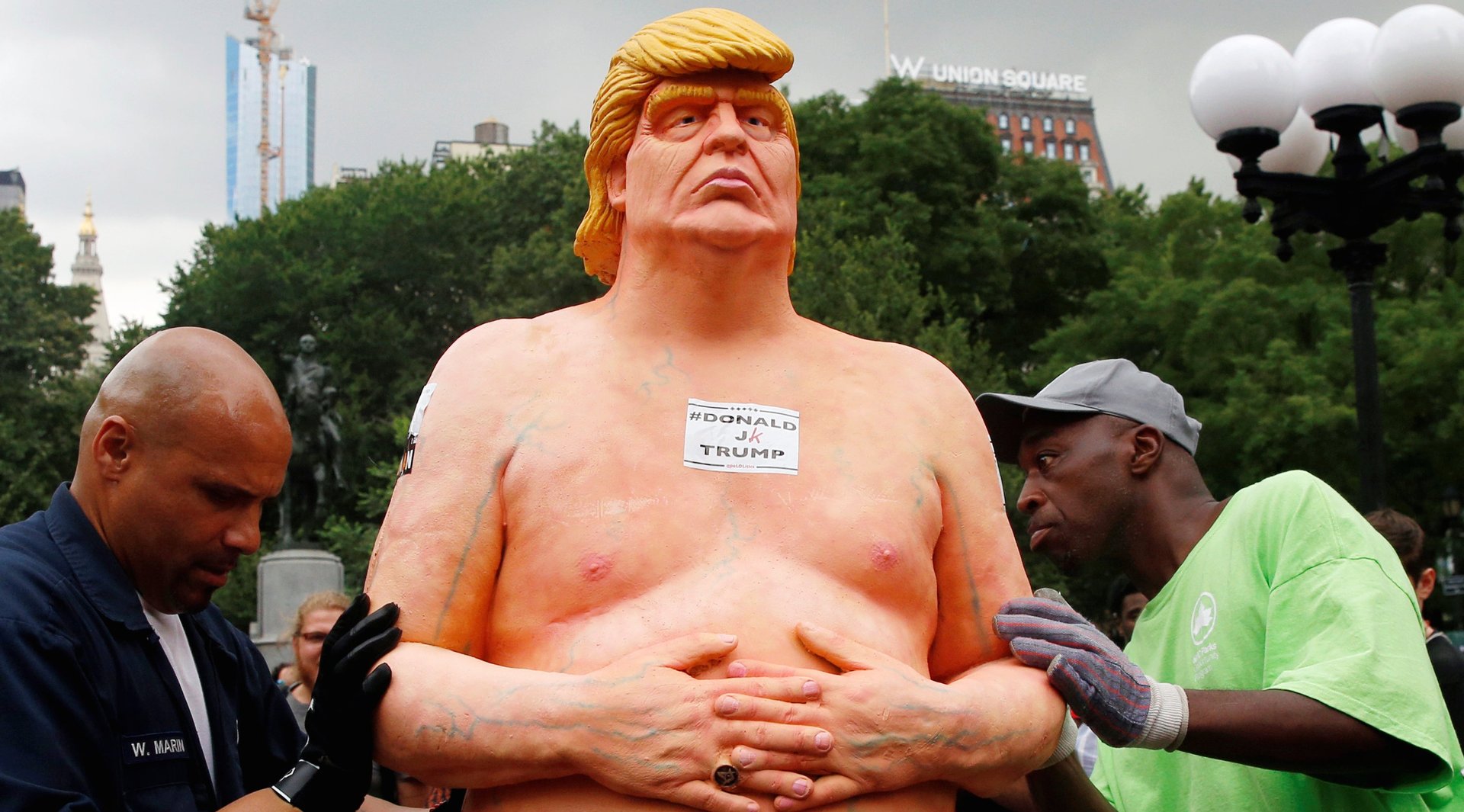Hoping Donald Trump’s authoritarianism will lead to better art is the worst kind of wishful thinking
Some of the greatest art ever created has come out of suffering and hardship. From African-American spirituals to Anne Frank’s diaries to Ai Weiwei’s creations, people have often used art to chronicle humanity and resistance in the face of terrible pain.


Some of the greatest art ever created has come out of suffering and hardship. From African-American spirituals to Anne Frank’s diaries to Ai Weiwei’s creations, people have often used art to chronicle humanity and resistance in the face of terrible pain.
Inevitably, as America faces life under Donald Trump, some commenters have speculated that more authoritarianism and more hatred might lead to better art. This dream of a silver lining to fascism was succinctly expressed by the very successful—and very wealthy—American singer-songwriter Amanda Palmer. Pointing to the artistic flowering of Weimar Germany, the singer-songwriter Palmer argued that “frightening political climates make for really good, real, authentic art.” Trump may be bad, but at least, she claimed, he “is going to make punk rock great again.”
Palmer presumably believes that her optimism is inspiring. Mostly, though, I think it comes across as callous. Palmer is taking off for Australia for five years with her similarly successful husband, writer Neil Gaiman. Gaiman’s worth is estimated at $18 million; Trump’s tax cuts, aimed at the wealthiest, are almost certainly going to benefit Palmer, not hurt her.
Others will not be so lucky. As music writer Jessica Hopper pointed out soon after the election, if the GOP guts Obamacare, musicians and many other artists (as well as plenty of other Americans) will suffer. When you can’t get medicine to manage your chronic pain, how can you tour? When you have to spend all your income on medical care, how are you going to invest in supplies or carve out time to create away from your day job?
It is obscene to give oppressors credit—whether explicitly or implicitly—for art that emerges during times of great struggle. America’s racist system of segregation didn’t make James Baldwin a great writer; he became a great writer despite America’s best efforts to destroy him. The Soviets didn’t write Anna Akhmatova’s poems—but they did murder her husband. People will no doubt make great art about the viciousness and cruelty of Trump’s presidency. But that will not be Trump’s fault. He’d stop them if he could—and he will likely stop some of them.
What happens, for example, to artists in immigrant communities when Trump ramps up deportations? What happens to black artists who want to discuss racism in the US? The president-elect has personally attacked the casts of SNL and the Broadway hit Hamilton. These are big name artists with a lot of resources and backing. But there’s no reason Trump himself, or his surrogates, couldn’t go after smaller targets, too. The gamergate movement (a reactionary predecessor of Trump in many ways) terrorized critics and game designers, using death threats and constant harassment to force them out of their homes. Conservatives under Trump will have the resources and political clout to chill speech they dislike. Some artists, faced with threats to their livelihood and the safety of their family, will undoubtedly fall silent.
This shouldn’t be a surprise to anyone, not even to Amanda Palmer. Repression, historically, has not inspired art: It has crushed it. Under slavery, black people were viciously punished for learning to read—how many potential artists did slaveholders beat into nonexistence through denying them the tools to create? We will never know. As Virginia Woolf famously argued in A Room Of One’s Own, restrictions on women’s education and domestic demands and expectations were very effective in throttling women artists. For example, Woolf notes that Shakespeare’s sister anonymously “lies buried at some crossroads where the omnibuses now stop outside the Elephant and Castle.”
Isaiah Berlin writes that after the purges of 1937 and 1938, “Russian literature and thought emerged in 1939 like an area devastated by war, with some splendid buildings still relatively intact, but standing solitary amid stretches of ruined and deserted country.” Closer to home, at the time when Reagan’s presidency was supposedly inspiring all that great punk rock, his callous AIDS policy was helping to devastate a generation of gay creators in the theater and visual arts. Oppression kills—and dead artists don’t make art.
Of course, even in the face of terrible violence and injustice, some artists find ways to create. Louis Armstrong was able to escape the abject poverty of Jim Crow New Orleans to become one of the greatest American musicians of all time. Paul Celan, a Jewish writer who survived a Nazi work camp in Romania, wrote poetry about the Holocaust. David Wojnarowicz created art about the AIDS crisis. For that matter, Ava Duvernay, Beyoncé, Kendrick Lamar, and many others have made art in the last few years about police violence and the ongoing oppression of black people.
It’s true that one of the great themes of art is sadness and pain. But the election of Trump did not introduce hardship into the world. Death, illness, heartbreak and, yes, injustice occur even in the best of times. You don’t need to ratchet up oppression to lay the groundwork for great art. On the contrary, the great art that is made under oppression should be a reminder of what the world could be like, and what art could be like, if everyone were free.